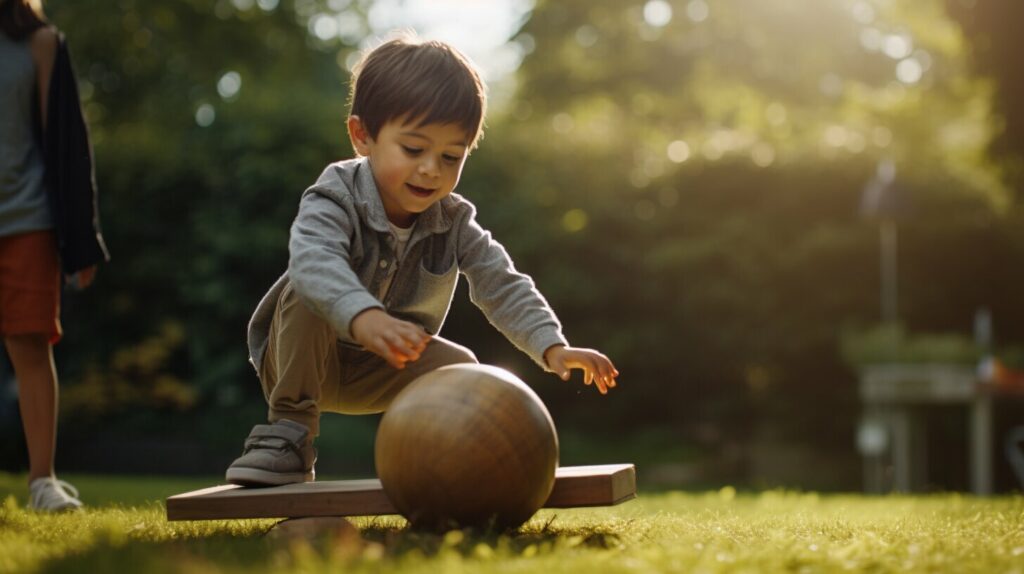Physics can be an intimidating subject for anyone, let alone children. But teaching your child about momentum doesn’t have to be dry and difficult. In fact, making learning fun and engaging can help them better understand and remember the concepts. In this article, we’ll provide you with simple and creative ways to explain momentum to your child.
First, let’s define momentum in simple terms. Then we’ll explore why it’s important and how you can introduce it to your child through play, everyday objects, sports, and visual aids. We’ll also showcase real-life examples where momentum is at play, making the concept more relatable. By the end of this article, you’ll have a better understanding of how to explain momentum to your child and how to make learning science fun.
Key Takeaways:
- Making learning fun and engaging can help children better understand and remember the concepts of physics.
- Explaining momentum in simple terms is important in helping children grasp the concept.
- Introducing momentum through play, everyday objects, sports, and visual aids can be effective teaching methods.
- Showcasing real-life examples where momentum is at play can make the concept more relatable.
Understanding Momentum: A Simple Definition
Momentum is a word used to explain how objects move. When an object is in motion – whether it’s rolling, bouncing, or being thrown – it has momentum. The momentum of an object is affected by its mass and its speed. The more massive an object is or the faster it moves, the more momentum it has.
Simply put, momentum is like a push that keeps an object moving. The strength of the push depends on how heavy the object is and how fast it’s going. So, if you were to push a toy car with the same force you would push a real car, the toy car would go much further because it has less mass and therefore more speed, resulting in more momentum.

Why is Momentum Important?
Teaching kids about momentum is not just about introducing a new physics concept, but also about helping them understand the world around them. Momentum is a fundamental principle of nature that plays a role in many everyday activities.
For example, when you’re riding a bike, you use momentum to keep moving forward. The faster you go, the more momentum you build up. When you stop pedaling, your momentum starts to slow you down.
Momentum also affects the outcome of sports and games. In basketball, a player uses momentum to jump higher when they run towards the basket. In bowling, the speed and direction of the ball’s momentum determine where it goes on the lane. Understanding momentum can help kids improve their coordination and performance in different activities.
Moreover, momentum plays a crucial role in safety. When you’re in a car, your seatbelt keeps you safe by harnessing the momentum that would otherwise propel you forward during a sudden stop. By teaching kids about momentum, you can help them understand why certain safety measures are necessary.
Overall, momentum is an essential concept that can help children learn about the world around them and make sense of their experiences.

Exploring Momentum through Play
Momentum can be a tricky concept for children to understand, but there are ways to teach them in a fun and engaging way. By using games and activities, you can help your child grasp the concept of momentum and make physics more enjoyable.
Exploring Momentum through Play
One great game to play with your child is the balloon rocket experiment. All you need is a balloon, a long piece of string, and some tape. Blow up the balloon and attach it to the string using the tape. Stretch the string across a room and hold it tight. Let go of the balloon and watch it zoom across the room, demonstrating the principle of momentum in action.
Another fun activity is playing with marble runs. Build a track with different obstacles and see how the marbles move through them. This will help your child understand how momentum affects the movement of objects and how different obstacles can affect momentum.
You can also teach your child about momentum through sports. Play catch with a ball or toss a Frisbee back and forth, and talk about how momentum affects the ball’s movement. This will help your child understand how momentum is used in sports like baseball, basketball, and football.
Crafting with Momentum
Lastly, you can also use crafts to teach your child about momentum. Use paper straws and ping pong balls to create your own miniature rollercoaster. This will help your child visualize the movement of objects and how momentum plays a part in it.
Overall, teaching your child about momentum through play is a fun and engaging way to make physics more understandable. When children are having fun while learning, they are more likely to retain the information and stay interested in the topic.

The Science Behind Momentum
When you hear the word “momentum,” you may think of something moving quickly. However, momentum refers to much more than just speed. In fact, momentum is a measurement of an object’s motion, and it takes both speed and mass into account.
When an object is in motion, it has momentum. The amount of momentum it has depends on its mass and velocity. In fact, the formula for momentum is:
| Momentum Formula: | p = mv |
|---|
Where:
- p is momentum
- m is mass
- v is velocity or speed
As you can see, momentum is a product of mass and velocity. This means that an object with a larger mass will have more momentum than an object with a smaller mass, moving at the same speed. Similarly, an object moving at a faster speed will have more momentum than an object moving at a slower speed, with the same mass.

This may sound complicated, but it’s actually a simple concept to understand when explained in simpler terms. Imagine a bowling ball and a tennis ball moving at the same speed. The bowling ball has more mass, so it has more momentum than the tennis ball. However, if the bowling ball and tennis ball had the same mass, the bowling ball would still have more momentum because it’s moving at a faster speed.
Understanding this concept is important because it helps us predict how objects will behave when they collide or interact. In fact, it’s one of the fundamental principles of physics!
Exploring Momentum through Play
Learning about physics can be fun and engaging for children when they are introduced to the concept of momentum through playful activities. Here are some examples of games that you can incorporate to help your child understand momentum:
| Game | Description |
|---|---|
| Bowling | Set up some pins and have your child roll a ball towards them. The more force they apply, the farther the pins will scatter. |
| Hot Potato | Pass a soft ball or beanbag around in a circle. Each time the item is caught, it gains momentum, and the child has to be ready for the catch. |
| Dominoes | Set up dominoes in a line and let your child push one over to watch the rest topple down. This shows how momentum is transferred from one object to another. |
Playing these games with your child can make learning about momentum feel like playtime rather than a lesson. It also helps them understand how momentum works in a tangible way.
If you want to take it a step further, try creating a homemade roller coaster using materials like cardboard and marbles. This allows your child to see how momentum works in a real-life scenario.

Using games and activities is an excellent way to introduce your child to the concept of momentum. They get to learn and play at the same time, making it an enjoyable experience for them.
Momentum in Sports and Play
Understanding momentum is especially important for children who enjoy sports and other physical activities. It affects how an object moves and can impact the outcome of a game or activity.
Think about a game of soccer. When a player kicks the ball, the ball gains momentum and moves forward. If another player intercepts it with their foot, they must use their knowledge of momentum to control the ball and determine where it will go next.
Similarly, when swinging on a swing set, the higher you go, the more momentum you gain. This momentum affects how high you can swing and how fast you can go.

By helping children understand the role momentum plays in sports and play, they can develop a greater appreciation for the physical world and learn to navigate it more effectively. Additionally, learning about momentum can inspire them to explore different activities and gain a deeper understanding of the physics behind them.
Visualizing Momentum Through Visual Aids
Visual aids, such as diagrams and illustrations, can greatly enhance a child’s understanding of momentum. They can make the abstract concept more concrete and easier to grasp. Here are some tips for creating simple visuals:
- Use arrows to indicate the direction of an object’s movement.
- Use different colors to represent different objects or forces.
- Include simple labels or captions to explain what is happening in the visual.
For example, you can draw a picture of a toy car rolling down a ramp with arrows indicating the direction of movement and different colors representing the car and the ramp. This can help children visualize how momentum works in a simple, yet effective way.

Using visual aids in combination with hands-on activities and real-life examples can create a well-rounded learning experience for children. It can also make learning physics more fun and engaging, encouraging children to explore and discover more about the world around them.
Real-Life Applications of Momentum
Understanding momentum is not just a theoretical concept but also plays a crucial role in various aspects of our lives. Here are some real-life examples where momentum is at play:
| Examples | Description |
|---|---|
| Roller coasters | Roller coasters are designed to use momentum to provide a thrilling experience. The initial ascent builds up potential energy, which is then transformed into kinetic energy as the coaster descends, creating an adrenaline-pumping ride. |
| Car safety | The laws of momentum apply to car safety as well. When a car is in motion, the occupants have momentum, just like the car. In case of an accident, seat belts and airbags are designed to protect the passengers by preventing their bodies from experiencing sudden changes in momentum. |
| Sports | In sports such as football, basketball, and hockey, momentum plays a critical role. A team with momentum is likely to have the upper hand, and the opposing team will find it challenging to stop them. |
| Swimming | Swimmers use momentum to their advantage. The faster they move, the more momentum they generate, which enables them to swim more efficiently and glide through the water with less effort. |
By understanding the concept of momentum, children can comprehend and appreciate the world around them better. Moreover, it opens up a whole new world of scientific thinking and experimentation, which can prove useful in their academic and professional careers.
Image source: 
Frequently Asked Questions about Momentum
Here are some common questions children may have about momentum:
-
What is momentum?
Momentum is the force of a moving object. The more momentum an object has, the harder it is to stop it from moving. -
How is momentum different from speed?
Speed is how fast an object is moving. Momentum is how hard it is to stop an object from moving. For example, a fast-moving car has a lot of speed but also a lot of momentum because it would take a lot of force to stop it. -
Why is momentum important?
Understanding momentum can help us predict the outcome of moving objects and help us make decisions about how to control or stop them. It is also important in sports and play. -
How can I experience momentum?
You can experience momentum by swinging on a swing, throwing a ball, or riding a bike downhill. Anytime you feel the force of movement, you’re experiencing momentum. -
What happens to momentum if the object changes direction?
If an object changes direction, its momentum changes with it. For example, if you throw a ball and it bounces back to you, its momentum changes as it changes direction. -
Can momentum be lost?
Momentum can only be transferred from one object to another, it cannot be lost. So if you throw a ball, the momentum transfers from your hand to the ball and then to the air as it moves.
Remember, momentum is all around us, and by understanding it, we can better understand the world we live in.

Conclusion
Congratulations! You’ve made it to the end of our guide on explaining momentum to children. We hope you’ve found our tips and suggestions useful in making the concept of momentum easy and fun for your child to understand.
Remember, it’s important to emphasize the relevance of physics in everyday life and to approach teaching it in an engaging way. By doing so, you can help your child foster a love and appreciation for science!
Final Thoughts
If you have any additional questions or concerns about explaining momentum to your child, don’t hesitate to reach out to your child’s science teacher or consult additional resources online. Always remember that learning should be fun and enjoyable, so don’t be afraid to get creative!
Thank you for reading and happy teaching!
Is There an Easy and Fun Way to Explain Coding to a Child?
Introducing coding to children is made effortless with fun coding approaches. By using interactive games, colorful visuals, and engaging activities, kids can grasp the fundamental concepts of coding while having a blast. These approaches encourage creativity, problem-solving, and logical thinking, making the learning process both easy and enjoyable for children.
Frequently Asked Questions about Momentum
Q: What is momentum?
A: Momentum is a physics concept that refers to the quantity of motion an object has. It takes into account both an object’s mass and its velocity.
Q: How can I explain momentum to a child?
A: You can explain momentum to a child by using relatable examples, such as a moving car or a rolling ball. You can also emphasize that momentum is related to how hard it is to stop an object once it’s in motion.
Q: Why is momentum important?
A: Momentum is important because it helps us understand how objects move and interact with each other. It is also useful for explaining the outcomes of collisions or sports activities.
Q: Can momentum change?
A: Yes, momentum can change. It can change if the object’s mass or velocity changes, or if an external force acts on the object.
Q: How can I teach my child about momentum through play?
A: You can teach your child about momentum through play by engaging in activities like rolling or bouncing balls, playing with toy cars, or even experimenting with a simple pendulum. These activities allow children to observe and experience momentum in action.
Q: What are some real-life examples of momentum?
A: Some real-life examples of momentum include a moving train, a person riding a bike, a ball being thrown, or a car coming to a stop. These examples all involve objects in motion and demonstrate how momentum comes into play.
Q: Can you give me a simple definition of momentum?
A: Sure! Momentum is how hard it is to stop something from moving once it’s already in motion. It depends on how heavy the object is and how fast it’s moving.






